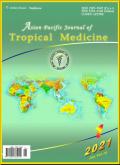Molecular epidemiology of piliated pneumococcal isolates at a major tertiary hospital in the Klang Valley, Malaysia
IF 1.6
4区 医学
Q3 PUBLIC, ENVIRONMENTAL & OCCUPATIONAL HEALTH
引用次数: 0
Abstract
Objective: To characterise a collection of pili-carrying and none pili-carrying pneumococcal isolates of clinical origin for serotypes, antibiotic resistance and genotype. Methods: In total, 42 clinical isolates were collected between October 2017 and December 2019. Those isolates were analysed for antimicrobial susceptibility, serotype distribution, detection of pneumococcal virulence and pilus genes. Multilocus sequence typing was performed only for piliated isolates, followed by phylogenetic analysis. Results: The common isolation sites among the pneumococcal isolates were tracheal aspirate (28.6%), blood (26.2%), and sputum (23.8%). Fifty percent isolates were resistant to erythromycin, tetracycline (50.0%) and trimethoprim-sulfamethoxazole (43.0%). The most frequent were serotypes 19F (28.6%), 6A/B (23.8%) and 19A (14.3%). Piliated isolates were detected in a small proportion (33.3%); 64.3% were multidrug-resistant. ST320 was the prevalent sequence type among the piliated isolates and genetically related to the Pneumococcal Molecular Epidemiology Network clones Taiwan19F-14 (CC271). In the phylogenetic analysis, some piliated isolates showed a close association having similar ST320, carrying serotype 19A and both pilus genes indicating their clonal spread. Conclusions: Pneumococcal lineages of piliated isolates have been globally disseminated and pili could have played a role in the spread of antibiotic resistant clones.马来西亚巴生谷一家大型三级医院中肺炎球菌毛状分离株的分子流行病学研究
目的:对临床来源的携带菌毛和不携带菌毛的肺炎球菌分离株的血清型、抗生素耐药性和基因型进行鉴定。方法:2017年10月至2019年12月,共收集42株临床分离株。对这些分离株进行了抗菌药物敏感性、血清型分布、肺炎球菌毒力检测和菌毛基因分析。只对菌毛分离株进行多基因座序列分型,然后进行系统发育分析。结果:肺炎球菌分离株中常见的分离位点为气管分泌物(28.6%)、血液(26.2%)和痰(23.8%),50%的分离株对红霉素、四环素(50.0%)和甲氧苄啶-磺胺甲恶唑(43.0%)具有耐药性,最常见的是血清型19F(28.6%、23.8%和14.3%);耐多药占64.3%。ST320是菌毛分离株中的流行序列型,与肺炎球菌分子流行病学网络克隆Taiwan19F-14(CC271)具有遗传相关性。在系统发育分析中,一些菌毛分离株显示出密切的相关性,具有相似的ST320,携带血清型19A和两个菌毛基因,表明它们的克隆传播。结论:菌毛分离株的肺炎球菌谱系已经在全球传播,菌毛可能在抗生素耐药性克隆的传播中发挥了作用。
本文章由计算机程序翻译,如有差异,请以英文原文为准。
求助全文
约1分钟内获得全文
求助全文
来源期刊

Asian Pacific journal of tropical medicine
PUBLIC, ENVIRONMENTAL & OCCUPATIONAL HEALTH-TROPICAL MEDICINE
CiteScore
4.00
自引率
9.70%
发文量
1936
审稿时长
3-8 weeks
期刊介绍:
Asian Pacific Journal of Tropical Medicine (ISSN 1995-7645 CODEN: APJTB6), a publication of Editorial office of Hainan Medical University,is a peer-reviewed print + online Monthly journal. The journal''s full text is available online at http://www.apjtm.org/. The journal allows free access (Open Access) to its contents and permits authors to self-archive final accepted version of the articles on any OAI-compliant institutional / subject-based repository.
APJTM aims to provide an academic communicating platform for international physicians, medical scientists, allied health scientists and public health workers, especially those of the Asia-Pacific region and worldwide on tropical medicine, infectious diseases and public health, and to meet the growing challenges of understanding, preventing and controlling the dramatic global emergence and re-emergence of infectious diseases in the Asia-Pacific.
The journal is proud to have an international and diverse editorial board that will assist and facilitate the publication of articles that reflect a global view on tropical medicine, infectious diseases and public health, as well as emphasizing our focus on supporting the needs of public health practitioners. The APJTM will allow us to seek opportunities to work with others who share our aim, and to enhance our work through partnership, and to uphold the standards of our profession and contribute to its advancement.
 求助内容:
求助内容: 应助结果提醒方式:
应助结果提醒方式:


